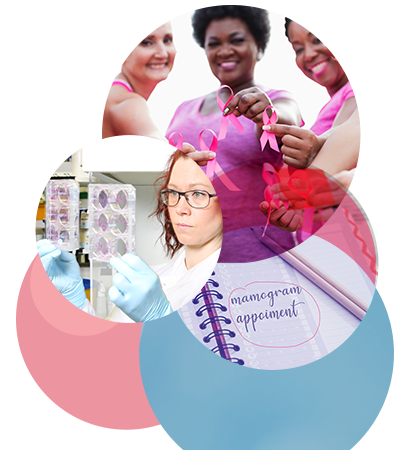Detecting Breast Cancer
Although breast cancer screening cannot prevent breast cancer, it can help find breast cancer early, when it is easier to treat. Talk to your provider about the benefits and risks of breast cancer screening, which breast cancer screening tests are right for you, and when you should have them.
Symptoms of breast cancer
Different people have different symptoms of breast cancer. Some people do not have any signs or symptoms at all.
Breast cancer can cause:
- A change in the way the breast feels. The most common symptom is a painless lump or thickening in the breast or underarm.
- A change in the way the breast looks. The skin on the breast may dimple or look like an orange peel. There may be a change in the size or shape of the breast.
- A change in the nipple. It may turn in. The skin around it may look scaly.
- A fluid that comes out of the nipple.
Types of breast cancer testing
There are several types of tests that doctors use to check for breast cancer:
- Screening mammogram – An X-ray of the breast
- Diagnostic mammogram – A more detailed X-ray of the breast
- Breast ultrasound – A machine that uses sound waves to take pictures of the inside of the breast (called sonograms)
- Magnetic resonance imaging (MRI) – A body scan that takes detailed pictures of the inside of the breast
- Biopsy Extracts – Tissue or fluid from the breast for testing
Learn more about how breast cancer screening saves lives
Mammography
During a regular physical exam, your doctor may check your breasts to look for lumps or changes. Depending on your age and risk factors, the doctor may advise you to have a mammogram. For most people, mammograms (X-rays of the breast) are the best way to check for breast cancer. You can get mammograms at your primary care provider’s (PCP’s) office. HPSM covers mammograms, so you get them at no cost.
Mammograms help find cancer early
- Early detection gives you more treatment options, improved treatment outcomes and better chances of surviving
- Finding cancer sooner helps prevent it from spreading to other areas of the body
- Cancer treatment can begin before you feel symptoms (such as a lump)
When to start getting mammograms
When to begin and how often to have mammograms may differ based on family history of breast cancer. Talk to your PCP about getting regular mammograms starting between ages 40 to 50. Then get a mammogram every one to two years after that. See what's right for you!
What happens during a mammogram
You will place your breast on an X-ray machine and a plate will press on top of it. This will keep your breast still while the machine takes an X-ray. Then an X-ray of the side of your breast will be taken. The same steps will be taken to get X-rays of your other breast. A total of four X-rays will be taken, and the procedure only takes a few minutes.
Make mammograms more comfortable
Mammograms are uncomfortable for most people and painful for some. They do not take very long though, and any discomfort or pain should go away once the X-rays are taken. You can reduce discomfort by:
- Scheduling your mammogram for a week after your period
- Avoiding caffeine the day of your appointment because it may make you more sensitive
- Finding a provider you are comfortable with and seeing the same one every year
After your mammogram
You will get the results later. If the X-rays show something that the provider is not sure about, they will ask you to come back to take a sample of the cells (biopsy). This is common, but less than 10% of people who come back for tests are diagnosed with cancer.
Benefits and risks of screening
Every screening test has benefits and risks, which is why it’s important to talk to your doctor before getting any screening test, like a mammogram.
The biggest benefit of regular screening is finding cancer early when it’s easier to treat. That is why public health guidance recommends mammograms for all women starting at age 50 and some women as early as 40.
Some of the risks of regular breast cancer screening include:
- False positive test results, when a doctor sees something that looks like cancer but is not. This can lead to more tests, which can be expensive, invasive, time-consuming, and may cause anxiety.
- Overdiagnosis, which is when doctors find a cancer that would not have gone on to cause symptoms or problems, or even may go away on its own.
- False negative test results, when a mammogram does not detect cancer that is there, it can delay finding a cancer and getting treatment.
To learn more about breast cancer screening, visit the Centers for Disease Control website
Breast self-awareness
Being familiar with how your breasts look and feel can help you notice symptoms such as lumps, pain, or changes in size that may be of concern.
If you notice any changes in your breasts during self-exams, call your primary care provider (PCP). Describe what you noticed. Your PCP will say if you should schedule a visit.
